How Has History Affected the People of Southeast Asia?
Who Are the People of Southeast Asia?, What Is Southeast Asia Like Today?
Southeast Asia has two peninsulas. One is called the Indochina Peninsula. The other is the Malay Peninsula. Find these two peninsulas on the map. There are also two large groups of islands—the Philippines and the Malay Archipelago. An archipelago (ahr-kuh-pel-uh-goh) is a large group of islands.
Southeast Asia lies between China and India. Many people from China and India settled here. Each group brought their own culture. They developed trade with both countries. Find the main rivers in the region. Rivers and canals are important to people in the region. They supply routes for transportation and make fertile soil for farming.
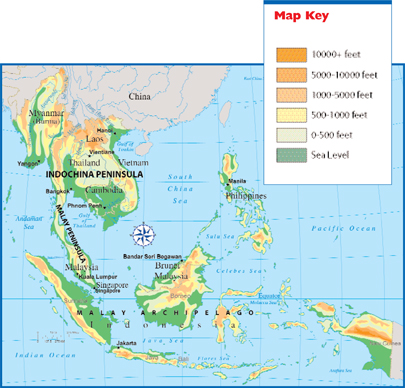 Physical Map of Southeast Asia
Physical Map of Southeast Asia
From A.D. 800 to the mid-1200s, a civilization developed in Southeast Asia called the Khmer (kuh-mer). The Khmer lived in what is now Cambodia. They built a Hindu temple called Ankor Wat. Hinduism (hin-doo-iz-uhm) is the main religion of India. It teaches that all things are part of a spirit called Brahman.
Later, another religion came from India called Buddhism. Buddhism is based on the teachings of a man named Siddhartha Gautama (sihd-dahr-tuh gau-tah-muh)—the Buddha. It teaches that people suffer because they want things, such as money or power. Buddhism became the main religion in the region. Over time, wars destroyed the Khmer civilization.
By the 1800s, Portugal, Spain, Britain, and France set up colonies in the area. Each country wanted to control trade. Europe brought Christianity to the region. They also brought different languages and customs. After 1970, most areas in Southeast Asia became independent nations.
Who Are the People of Southeast Asia?
Many groups shape the region's culture. In addition to Buddhism, Hinduism, and Christianity, the people of Indonesia and Malaysia follow Islam. This diverse culture blends native, Indian, Chinese, and Europeans ways of life. Many languages are spoken in Southeast Asia—native languages, Chinese, French, and English.
The most important food crop in Asia is rice. Almost everyone eats rice with a meal. A popular greeting to someone is “Have you eaten your rice yet?”
What Is Southeast Asia Like Today?
Most people still live in rural villages. They are subsistence farmers. Many families travel to the cities to find jobs. The crowded cities have traffic problems, air pollution, and slums. There are too many cars, trucks, and buses. In Bangkok, people ride through traffic on a three-wheel motorcycle called a tuk-tuk (took-took). Tourism is now important for the economy. Visitors enjoy warm weather, beautiful beaches, and historic sites.
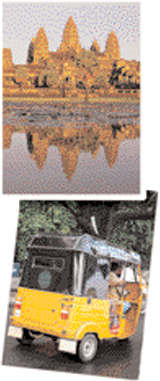 Angkor Wat, Cambodia
Angkor Wat, Cambodia
A tuk-tuk>
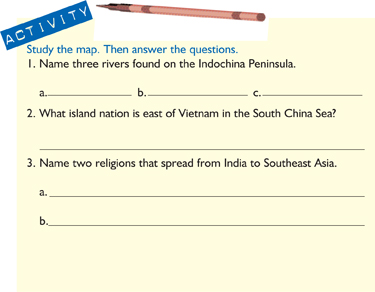
![]()
How Has History Affected the People of South Asia?
Let's travel east to the Indian subcontinent. Find these countries on the map: India, Pakistan, Bangladesh, Nepal, Bhutan, and the island nations of Sri Lanka and the Maldives. They make up the region called South Asia.
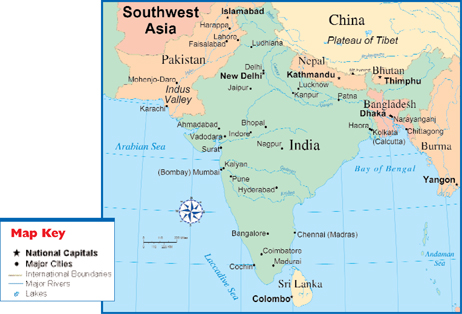 Political Map of South Asia
Political Map of South Asia
Civilization in India developed around the Indus River Valley. Locate the Indus River on the map. The Harappan (huh-re-puhn) civilization (2300 B.C. to 1700 B.C.) was the earliest Indus Valley civilization. They built two great cities—Harappa (huh-re-puh) and Mohenjo-Daro (mo-hen-joh dar-oh). These cities were well planned. Some buildings even had running water.
About 1700 B.C. rivers in the area began to dry up. Others changed their course. This caused floods. People began to leave the cities. Finally, the Indus Valley civilizations disappeared.
A new group called Aryans (air-ee-uhnz) arrived in the region. They were from Central Asia. Aryans became the most important group in India. They organized people into classes based on their jobs. The four main classes were Brahmins (brah-muhns), or priests; Kshatriyas (ksha-tree-uhs), or rulers and warriors; Vaisyas (vysh-yuhs), or farmers and traders, and Sudras (soo-drahs), or workers. This created a caste system. A caste system divides people into groups based on their job, birth, or wealth. Special rules stopped people from marrying or living with members of a different caste.
In 1526, the Mughal (moo-guhl) Empire began. This was India's greatest empire. Mughal rulers were Muslims. But they let everyone practice their own religion. Hindus, Christians, and Muslims all lived together in peace. One of India's most beautiful buildings is the Taj Mahal. It was built during the Mughal rule. The British defeated the Mughal Empire in 1857. Britain then ruled India until 1947.
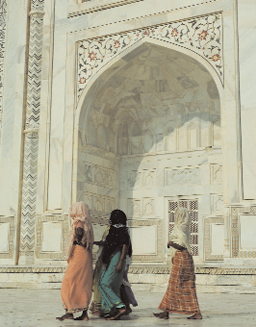 Indian women walk in front of the Taj Mahal. Note the beautiful detail in the stonework.
Indian women walk in front of the Taj Mahal. Note the beautiful detail in the stonework.
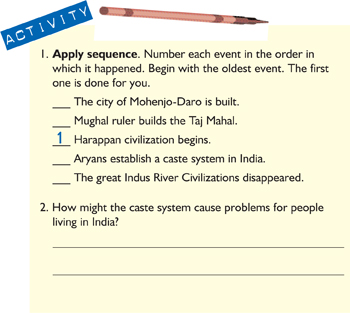
Who Are the People of South Asia?
Most of the people in India and Nepal are Hindus. Hindus respect all living things. Therefore, they are vegetarians. They do not eat meat, fish, or birds. To Hindus, the Ganges (gan-jeez) River is the most sacred place. People are baptized in the river. When they die, their ashes are scattered in the river. Locate the Ganges River on the map on page 92. The river is 1,560 miles (2,510 k) long. Notice that it flows through four countries. About one in every twelve people (8.5 percent of the world's population) lives in the area around the Ganges. It starts high up in an ice cave on the southern slopes of the Himalaya Mountains.
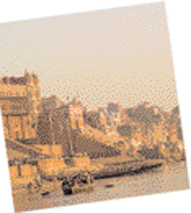 Varanasi, India, Ghats (ceremonial stairs) on the Ganges River
Varanasi, India, Ghats (ceremonial stairs) on the Ganges River
The river is used for industry, as a source of electricity, as rich farmland, and for washing and bathing. The Ganges, like many rivers, forms a delta at its mouth. Find the Plateau of Tibet on the map. This plateau is called the “roof of the world” because it is so high. Mt. Everest, the world's tallest mountain, is on the Plateau of Tibet.
People in Pakistan, Kashmir, and the Maldives are mostly Muslim. They follow Islam. Muslims pray five times a day. When they pray, they face the holy city of Mecca in Saudi Arabia. They celebrate many religious holidays.
In 1947, India became independent from Britain. Hindus and Muslims did not agree on who should rule the new country. Britain decided to divide India into two separate countries—India and Pakistan. The people in India are mostly Hindu. The people in Pakistan are mostly Muslim. Even today, the two countries still do not trust each other.
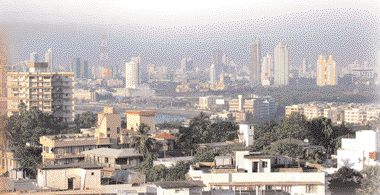 Mumbia (Bombay) skyline
Mumbia (Bombay) skyline
What Is South Asia Like Today?
More than one billion people live in India. Two of the largest cities in the world are in India. The streets are very crowded. Pollution is very bad. Most of the people still live in villages. They are farmers.
The huge populations affect all of the countries in the region. More land is needed to grow food. So when forest are cleared, valuable soil is washed away. The region struggles to feed growing populations and protect its land and resources.
The tiny country of Bhutan is in the Himalayas (see map on page 92.) It lies between India and China. Because of the mountains, the country is isolated from other areas. A king rules this Buddhist country. The king keeps the number of visitors low. This protects the environment. It also protects people's way of life. To protect itself from China, Bhutan has close ties with India.
Nepal is also a kingdom in the Himalayas. In 30 years, the population has increased from nine million to twenty million. There is not enough land to grow food. Pollution and soil erosion are big problems. Only 29 percent of the people in Nepal can read or write.
In this crowded region of the world, people suffer from many natural disasters. Earthquakes, floods and tsunamis (tsoo-nah-mees) make life difficult. On December 26, 2004, the worst earthquake in history happened near the west coast of Indonesia. It caused tsunamis across the Indian Ocean. They killed thousands of people living near the coast. It damaged fishing and agricultural industries.
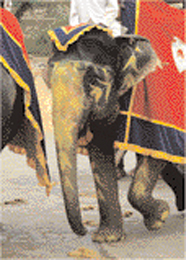 A decorated elephant in Amber, India
A decorated elephant in Amber, India
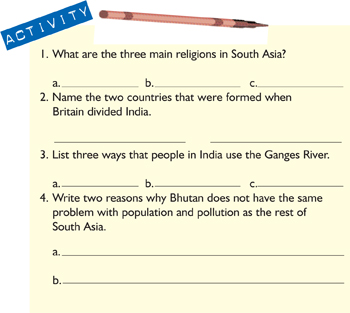
Additional topics
- Looking At JAPAN - Where in the World Is Japan?, What Is the Geography of Japan?
- How Has History Affected the People of Central Asia? - Who Are the People of Central Asia?, What Is Central Asia Like Today?
- Other Free Encyclopedias
History Reference: Ancient History & World HistoryThe Eastern Hemisphere - Asia



